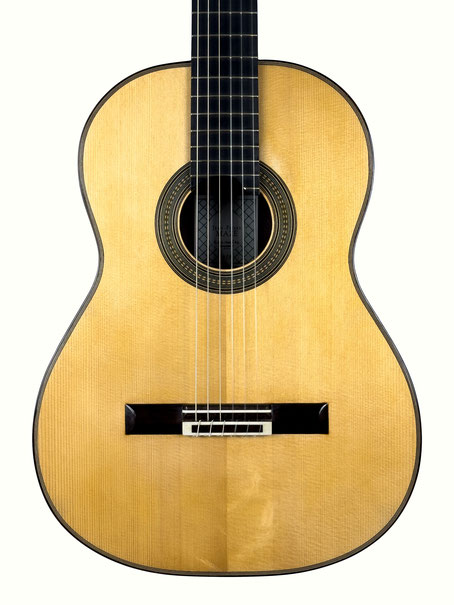Jean-Pierre Mazé

| Country : | France - Carantec |
| Year : | 2019 |
| Scale length : | 65 cm |
| Top : | Spruce |
| Back & side : | Indian rosewood |
| Fingerboard : | Ebony - 53 mm |
| Body length : | 485 mm |
| Body width : | 275/240/365 mm |
| Body depth : |
90 / 98 mm |
| Weight : | 1 655 g |
| Action : | 3 / 3,4 mm |
| Condition : | Excellent |
| Price : |
On request |

Jean Pierre Mazé was born in Saint Pol de Léon in Brittany in a large family (he is the sixth of 10 children), a family with little interest in music and not at all musical. He was an exception among his brothers and sisters in that he was fascinated by music from a very young age. He listened to all kinds of music on the family record player but especially classical music. He only started playing instruments at the age of 13 on a plywood guitar built by his older brother. He gradually switched from accompanying songs to classical guitar, always self-taught. “The music of the film ‘Jeux Interdits’ by René Clément, interpreted by Narciso Yepes, was like for many young people of my generation, a revelation”. He has dreamed of making guitars since he was a teenager, knowing that he was a musician and that he was good with his hands, but he did not dare to start making a guitar. He tried making large Romanian naïs (pan flutes), which were very fashionable in the early 1970s. The meeting in Paris of accomplished classical guitarists, notably Carlos Marín, then a student of Alberto Ponce, confirmed his vocation as a guitar maker. “But this time, there was no question of tinkering”.
In September 1979, he dared to call Robert Bouchet, the most famous French guitar maker, played by the Presti-Lagoya duo, Julian Bream, Emilio Pujol, etc. "He could understand me, having started lutherie himself very late (48 years old) and having practiced another profession at the same time. "He could understand me, having started lutherie himself very late (at 48) and having practiced another profession at the same time as lutherie. Our meeting was the chance of a lifetime. He takes part in the Friday evening meetings which will last until the death of Robert Bouchet in August 1986. He begins by making the specific tools for the guitar: trusquins to inlay the rosette and the inlay purfling, dies for the inlay purfling and, above all, the mold for the top and back. Robert Bouchet validates each tool. Then begins the apprenticeship of the different phases of guitar making based on a precise plan. Robert Bouchet insists on the general conception of the guitar, on the exact thicknesses, the bracing and teaches him his conception of the French guitar based on a few principles: aesthetics always sober, never flashy - for the sound, a clear and elegant tone but not too typical which respects the playing and the temperament of each guitarist - for the balance: equality of all the notes, supreme difficulty, for the best possible balance; harmonic balance which favors the length of the sound, including in the treble and the bass, and allows for a good projection.
About his first guitar, Jean-Pierre Mazé says: "It took me a long time to make my first guitar. According to Bouchet, the result was promising, but I still had a long way to go to make my ideal guitar. Throughout his professional career at the Ministry of Finance in Paris, he spent 8 to 10 hours a weekend in his small workshop. Each new guitar was tested by his friends Carlos Marín, Minoru Inagaki, Azusa Shimizu, Jean-Yves Casala (one of the first to play on one of his guitars) or Hervé César and Hervé Pichon. After the death of Robert Bouchet, he met Mr. Sho Kido, director of some guitar stores in Japan, who bought his guitar number 5. Jean-Pierre Mazé quickly made a name for himself in Japan, at the risk of being less known by French guitarists, especially since his production was confidential. He participated in the exhibition and concerts dedicated to the centenary of Bouchet's birth in September 1998 in Tokyo. Later, he contributed to the work of Catherine and Bruno Marlat for the publication of Bouchet's workshop notebook by the Musée de la Musique de La Villette. He made guitars for Carlos Marín, Jean-Yves Casala, Hervé César and for the young Maud Laforest, then 14 years old (!). In 2007, Yasuaki Hiura, a Japanese student of Raphael Andia, ordered a guitar from him and asked for a "universal neck". "Until then my guitars were appreciated but considered difficult to play. This adjustment of the neck made the playing more comfortable and revealed the full capabilities of my guitars. For the past two years, he has been advising Renan Aouam, who trained at the Spanish school and who wishes to join the French school of lutherie in the tradition of Robert Bouchet.
The guitar presented here is a superb instrument. The aesthetic is beautiful and elegant, the woods are of the best choice and the craftsmanship finely realized. Soundwise, the notes are colorful, vibrant and rich in harmonics. The deep, refined timbre and lyrical expressiveness give this guitar a strong, singular character. A rare instrument to discover
















